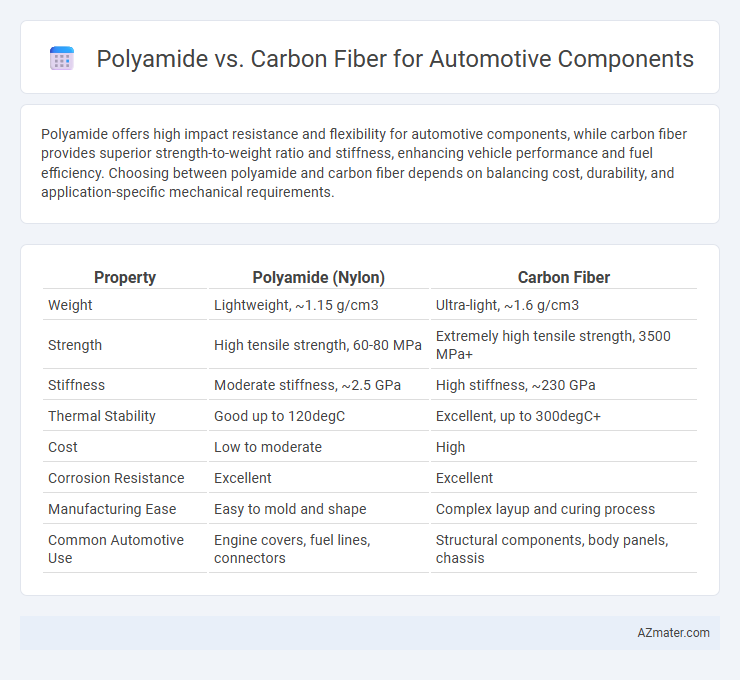Polyamide offers high impact resistance and flexibility for automotive components, while carbon fiber provides superior strength-to-weight ratio and stiffness, enhancing vehicle performance and fuel efficiency. Choosing between polyamide and carbon fiber depends on balancing cost, durability, and application-specific mechanical requirements.
Table of Comparison
| Property | Polyamide (Nylon) | Carbon Fiber |
|---|---|---|
| Weight | Lightweight, ~1.15 g/cm3 | Ultra-light, ~1.6 g/cm3 |
| Strength | High tensile strength, 60-80 MPa | Extremely high tensile strength, 3500 MPa+ |
| Stiffness | Moderate stiffness, ~2.5 GPa | High stiffness, ~230 GPa |
| Thermal Stability | Good up to 120degC | Excellent, up to 300degC+ |
| Cost | Low to moderate | High |
| Corrosion Resistance | Excellent | Excellent |
| Manufacturing Ease | Easy to mold and shape | Complex layup and curing process |
| Common Automotive Use | Engine covers, fuel lines, connectors | Structural components, body panels, chassis |
Introduction to Polyamide and Carbon Fiber in Automotive Applications
Polyamide, commonly known as nylon, is widely used in automotive components due to its excellent mechanical strength, heat resistance, and lightweight properties, making it ideal for parts like fuel lines, gears, and housings. Carbon fiber composites offer superior strength-to-weight ratio, high stiffness, and exceptional durability, which significantly enhance vehicle performance and fuel efficiency when used in structural components such as body panels, chassis parts, and suspension systems. The choice between polyamide and carbon fiber depends on specific application requirements, balancing cost, weight reduction, and mechanical performance.
Material Properties: Polyamide vs Carbon Fiber
Polyamide offers excellent toughness, flexibility, and chemical resistance, making it suitable for impact-prone automotive components, while carbon fiber excels in high tensile strength, stiffness, and lightweight characteristics essential for performance and structural parts. Carbon fiber's superior modulus-to-weight ratio allows for significant weight reduction and enhanced fuel efficiency, though polyamide provides better fatigue resistance and easier manufacturability. The choice hinges on balancing durability, strength, weight, and cost in automotive applications.
Weight Considerations: Lightweighting Benefits
Polyamide offers a significant weight reduction compared to traditional metals, enhancing fuel efficiency and reducing vehicle emissions. Carbon fiber provides an even greater lightweighting advantage due to its exceptional strength-to-weight ratio, leading to improved vehicle performance and handling. The optimal choice depends on balancing cost, durability, and weight savings for specific automotive components.
Mechanical Strength and Durability Comparison
Carbon fiber exhibits superior mechanical strength and stiffness compared to polyamide, offering higher tensile strength and excellent fatigue resistance essential for high-performance automotive components. Polyamide, while less rigid, provides notable impact resistance, flexibility, and good durability under varying thermal and chemical environments, making it suitable for parts requiring some elasticity. The durability of carbon fiber composites surpasses polyamide in high-stress applications, but polyamide's resilience against abrasion and moisture absorption enhances long-term reliability in less structurally demanding automotive parts.
Thermal Stability and Resistance Performance
Polyamide offers excellent thermal stability with a continuous use temperature up to 120degC, making it suitable for under-the-hood automotive components, but carbon fiber composites withstand much higher temperatures, typically above 250degC, ensuring superior thermal resistance in demanding applications. Carbon fiber's high thermal conductivity helps dissipate heat efficiently, reducing component deformation and enhancing performance under extreme thermal cycling. In terms of resistance, carbon fiber provides outstanding mechanical strength and fatigue resistance compared to polyamide, making it ideal for structural parts requiring long-term durability and thermal stability.
Manufacturing Processes and Cost Implications
Polyamide components benefit from injection molding and extrusion processes, enabling cost-effective high-volume production with short cycle times and minimal waste. Carbon fiber parts require labor-intensive layup or automated fiber placement and curing in autoclaves or ovens, significantly increasing manufacturing complexity and expenses. The raw material cost for carbon fiber is substantially higher than polyamide, affecting overall vehicle component pricing and limiting its use to high-performance or lightweight applications where cost can be justified.
Design Flexibility and Part Complexity
Polyamide offers superior design flexibility and can accommodate intricate geometries and complex shapes due to its moldability and thermoplastic properties, making it ideal for automotive components requiring detailed features. Carbon fiber, while limited in shaping compared to polyamide, provides exceptional strength-to-weight ratio and structural rigidity, best suited for performance-driven parts with simpler geometries. Selecting between polyamide and carbon fiber depends on balancing the need for detailed design complexity against the demand for high mechanical performance in automotive applications.
Environmental Impact and Sustainability
Polyamide offers lower embodied energy and better recyclability compared to carbon fiber, making it a more sustainable choice for automotive components in terms of environmental impact. Carbon fiber boasts superior strength-to-weight ratio, which improves fuel efficiency and reduces emissions during vehicle operation, but its production involves high energy consumption and challenges in recycling. Selecting polyamide supports circular economy initiatives, while carbon fiber's environmental benefits are maximized when paired with advanced recycling technologies.
Common Automotive Components: Use Cases
Polyamide is widely used in automotive components such as fuel lines, air intake manifolds, and electrical connectors due to its excellent chemical resistance and lightweight properties. Carbon fiber is preferred for high-performance parts like drive shafts, body panels, and suspension components because of its superior strength-to-weight ratio and stiffness. Both materials balance weight reduction and durability but are selected based on specific performance and cost requirements in automotive applications.
Future Trends in Automotive Material Selection
Polyamide and carbon fiber each offer distinct advantages for automotive components, with polyamide delivering excellent flexibility, corrosion resistance, and cost-efficiency, while carbon fiber provides superior strength-to-weight ratios and enhanced durability. Future trends in automotive material selection emphasize lightweight composites like carbon fiber reinforced polymers to improve fuel efficiency and electric vehicle range, alongside bio-based or recycled polyamides to meet sustainability goals. Advances in hybrid material systems combining polyamide matrices with carbon fiber reinforcements are expected to dominate, optimizing performance, manufacturability, and environmental impact in next-generation automotive designs.

Infographic: Polyamide vs Carbon fiber for Automotive component
 azmater.com
azmater.com